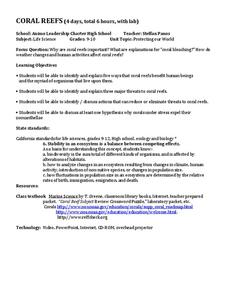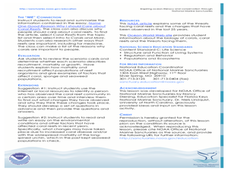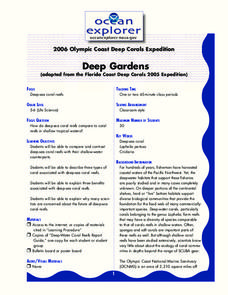Curated OER
What's Down There
Students write an essay about the coral reefs. In this oceanography lesson plan, students investigate the reef of Bonaire and compare it to reefs that are not thriving. Students then explore the differences that contribute to the...
Curated OER
Deep Gardens
Students compare and contrast deep-sea coral reefs with shallow-water coral reefs. In this underwater ecology lesson, students describe three types of coral and explain why scientists are concerned about the future of deep-sea coral.
Curated OER
Who Has the Data? Monitoring Coral Reefs
Young scholars access data to characterize coral reefs. In this scientific research lesson plan, students access data and explain the need for such data when monitoring coral reefs. They will identify and explain three major threats to...
Curated OER
Coral Reefs
Young scholars research coral reefs and identify their benefits to humans, threats to the reef, how to reduce and eliminate threats, and more. In this coral reef lesson plan, students research the reefs, and take a field trip to an...
Curated OER
We're All In This Together
Students discover what a coral reef is and the animals that live there. In this ecosystem lesson plan, students act out a story with ocean organisms. They answer questions that show the interdependency of the sea animals.
Curated OER
Architects of the Coral Reef
Students discuss reproduction in Cnidaria. in this coral reef lesson, students describe five characteristics of Cnidaria and compare and contrast the four classes. They describe the reproduction strategies they use.
Curated OER
How do living and non-living structures affect coral reef habitats?
Students create model coral reefs showing surface area and including examples of communities. In this coral reef lesson, students research and explore the functions or benefits from a coral reef. Students design a benthic habitat....
Curated OER
Design a Reef!
Students explore coral reef ecosystems. In this ecosystems science lesson, students research coral reef ecosystems to determine the major functions the participating organisms must perform. Students construct a miniature coral reef...
Curated OER
Keeping Watch on Coral Reefs
Students investigate the dangers Coral Reefs face by investigating satellite images. In this environmental protection activity, students utilize the Internet to discover the types of satellites and sensors used to provide oceanographic...
Curated OER
The Changing Coral Reef
Students record changes in the composition of a coral reef. In this Coral Reef activity, students recognize the needs of Coral Reef species to survive. Students chart changes in population over time. Students write an essay about...
Curated OER
Saved by a Shark
Students explore the marine ecosystem and the importance of sharks. In this shark lesson, students look at photos of the Flower Garden Banks National Marine Sanctuary and discuss the animals that live there. They discuss which animals...
Curated OER
Deep Gardens
Students investigate the differences and similarities between shallow-water and deep-sea coral reefs. In this coral reef lesson, students research and compare the characteristics of reefs. Students describe various lifeforms in coral...
Curated OER
Monitoring Coral Reefs
Students investigate data on coral reef monitoring in a marine protected area in the Florida keys. In this coral reef lesson plan, students use online data from a marine protected coral reef to complete a worksheet about coral...
Curated OER
Biotic and Abiotic Factors
In this biotic and abiotic factors learning exercise, students complete 20 various types of questions related to biotic and abiotic factors. First, they write the vocabulary word that best completes the sentence. Then, students state an...
Curated OER
Coral Reef
For this word search worksheet, students locate 20 words related to the coral reef. The word list includes algae, eel, octopus, and seaweed.
Curated OER
Coral Reef Geography
In this coral reef geography worksheet, learners find locations of reefs on a globe or map. There are 10 instructions to follow. There is no map provided--an atlas, globe or map is needed.
Curated OER
Unusual Coral Reef Animals
In this science worksheet, students research an unusual coral reef animal. A list of 22 animals is provided to choose from or students may choose their own. After researching the animal, students illustrate the creature and write about...
Curated OER
Under the Sea
Students identify and interpret that non-fiction books have features like a table of contents, a glossary, and an index, which can efficiently help them find information. They also identify how to narrow the search for information by...
Curated OER
The Cay: Creatures of the Coral Reef
Students make a connection between science and literature. After reading the first five chapters of the novel The Cay, they describe the physical characteristics of a coral reef, as well as describe and distinguish between the many...
Curated OER
Fish Stix
Students explore population biology. They describe and demonstrate
a visual census technique commonly used to survey reef fish populations. In addition, they analyze and interpret data from surveys of coral reef fish populations.
Curated OER
Human Impact on the Life Cycle of Corals
Students study the life cycle of a coral reef. They then participate in a simulated village meeting in which they roleplay various characters who must review proposed legislation dealing with reef management.
Curated OER
Corals & Coral Reefs
Students describe a coral reef, how it is formed and its inhabitants. They explain the ecological and economic importance of coral reefs and discuss its present-day threats. Lesson contains adaptations for all levels.
Curated OER
Aquaculture
Learners examine an experiment in which 2 types of commercial fish are fed a new type of fish feed and a commercial fish feed which costs ten times as much. They calculate in the fish grow as well with the cheaper fish feed and then...
Curated OER
Habitats and Adaptations
Students research and describe the habitat and adaptations of a reef animal. After the student is assigned a habitat, they design and draw a cresture adapted to eat each food and to live in each habitat.

























